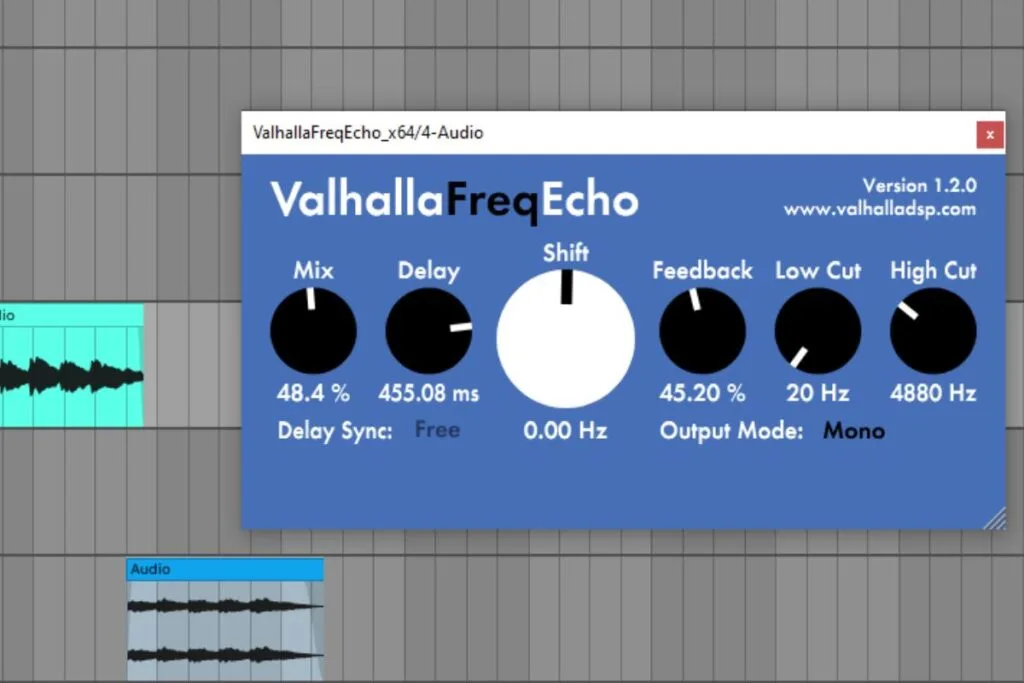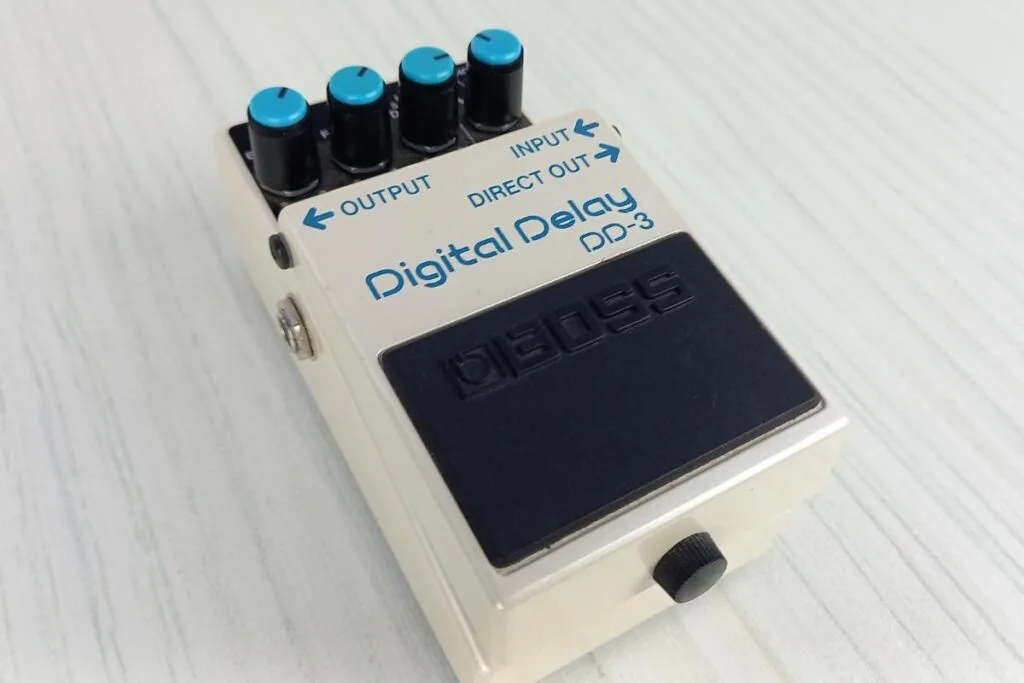There’s a constant battle happening between analog vs digital in music production, and delay is no exception. As a musician, it’s very useful for you to understand the differences between these two types of delay.
In this article, I’ve compared key factors of analog and digital delay, and have included original sound clips so that you can hear the difference for yourself.
For the most part, I’ve talked about analog and digital delay in terms of guitar pedals, as this is where the terms originated from. But, I’ve also made reference to “plugins” which are pieces of software designed to produce these effects in a Digital Audio Workstation (DAW).
Both analog and digital delay have their strengths and weaknesses. It all comes down to your own preference regarding their sound and functionality.
Let’s take a look at them, and see which one is right for you!
Analog vs digital delay summary
If you’ve got places to be, then here’s a table that quickly summarises the differences between analog and digital delay. If you read on, I’ve explained these points in a lot more detail.
| Analog delay | Digital delay | |
|---|---|---|
| How it works | “Bucket brigade” circuit creates copies of the signal that pass from one capacitor to another, being released at different times | Digital Sound Processing (DSP) chip copies the original signal and repeats it |
| How it sounds | Warm and dark sounding echoes that degrade with each repetition | Crisp sounding echoes that are a mirror-image of the original signal |
| Price | Guitar pedals: Analog delay guitar pedals are more expensive Plugins: No difference in plugin cost | Guitar pedals: Digital delay guitar pedals are cheaper Plugins: No difference in plugin cost |
| Pros | Rich and vintage sounding delay Able to hear the original signal clearer | Mirror-image copies of the original signal Able to repeat sounds with a longer pre-delay and for a longer time Can emulate analog sound in some cases |
| Cons | Pre-delay lengths are often shorter than digital delay pedals More expensive than digital delay pedals | Converts analog to digital, which can degrade the sound in cheaper pedals Echoes can easily overpower the original signal |
What is analog delay?
An analog delay device uses physical components and circuitry to create the delay effect. It has a distinctly warm and dark sound. While “analog” refers to the physical processing of the signal, many digital plugins and effects pedals are designed to emulate the warm analog tone.
How does it work?
Physical analog delay device (like a guitar pedal) create delay by using a “bucket brigade” circuit. This type of circuit gets its name from the old-timey process that firefighter’s used to put out fires: by passing buckets of water across a chain of people to reach the fire. It’s a great way of explaining what’s happening in the circuit.
The original signal passes through the pedal directly to the output, while copies of the signal pass through a chain of capacitors and reach the output over time, which creates the “echo” effect.
The signal degrades the further it passes through the chain, which rolls-off on the high-frequencies and gives the echoes a darker, warmer tone. This sound is the key feature of analog delay. Whether it’s a physical device or a plugin: it gives your echoes a warm, vintage feel.

However, analog delay devices are limited by their physical circuitry. The circuit limits the maximum amount of pre-delay (the time gap between the original signal and the first repetition), allowing for around 600ms of pre-delay.
Likewise, older devices often lack the extra “quality-of-life” features of digital pedals, such as tap tempo or MIDI control.
They also often cost more than digital delay pedals, due in part to their more complex circuitry. Older, “vintage” analog pedals will cost you even more.
Nowadays, modern digital guitar pedals and software plugins are good at emulating the sound of analog delay. They do this by applying a low-pass filter to the echoes, which removes some of the high-end frequencies, mimicking the signal degradation.
How does it sound?
Analog delay has a warm, dark sound due to how it rolls-off of the high end frequencies. This gives it an instantly classic quality with plenty of vintage character.
Here’s an example of how it sounds, using the “Valhalla Freq Echo” plugin.
First, here’s a single chord:
You can hear that the echoes lose their high end as they fade away.
Listen to how it sound when playing a small melody:
The echoes fade away and provide a rich bed of harmonies that support the original signal.
As the echoes are darker, it means that you can hear the original signal clearer. This helps the original signal to cut through the echoes, and prevents it from sounding cluttered.
Another benefit of analog delay guitar pedals in particular is that they keep your signal as an analog signal from input to output, unlike digital pedals. Some people find this to be a “truer” authentic tone, as it preserves the original input signal. But, you won’t get this benefit from analog delay plugins or digital pedal emulation.
As I mentioned, they do have some limitations, but plugins and some digital delay pedals are able to emulate the analog delay sound, while giving you the flexibility of a digital circuit.
When I need an analog delay sound, I use the plugin “Valhalla Freq Echo” by Valhalla DSP. It’s a free plugin that I recommend checking out. You can find it here on Valhalla’s website.
What is digital delay?
Digital delay is a device that uses a computer chip to create delay. This type of delay produces clean and clear echoes.
Delay plugins also count as digital delay, even the ones that emulate analog delay, as they’re run from a computer.
How does it work?
As the name suggests, digital delay uses digital processing to create the delay effect. In a physical device, like a guitar pedal, this means using a Digital Sound Processing (DSP) chip. Unlike the analog “bucket brigade” process, digital delay is much simpler.
The input signal is converted from analog to digital using an “Analog to Digital” (A/D) converters. Once the signal is digitized, a copy is made. The original signal is then converted back to analog using a “Digital to Analog” (D/A) converter and is output. The copied signal is then repeated depending on the settings.

The DSP chip gives you a lot more control over your delay settings. It can also be programmed in countless ways, allowing the manufacturer to add a wide range of features and functionality. This makes digital delay a very flexible and versatile effect, allowing for more time between repetitions, longer durations of echoing, analog emulation, and even MIDI integration.
As digital delay pedals use simpler circuitry, they’re often cheaper than analog delay pedals. Likewise, there are many free digital delay plugins.
How does it sound?
Digital delay gives a true reflection of the original signal, without any signal degradation.
Here’s an example using my BOSS DD-3 pedal. Again, let’s start with a single chord.
You can hear that it keeps all of its harmonic information as it fades away.
Now listen to how it handles a melody:
The echoes are much clearer and punchy.
Digital delay sounds crisper and cleaner compared to analog delay. To some, this is a good thing, others prefer the warmth of analog – it’s all down to your personal preference.
If you’re craving the analog tone, there are a lot of modern digital delay pedals and plugins that emulate the low-pass filter repetitions analog types of delay. So, you can get the functionality of digital delay, with the sound and character (mostly) of an analog delay.
Cheaper digital delay pedals may use lower-quality A/D and D/A converters, which can cause some issues with the original signal. Most pedals from name-brand manufacturers will be able to convert to and from digital without causing you any problems.
They’re also able to produce longer repetitions, as the DSP chip is better than analog circuit
I often use a digital delay pedal (a Boss DD-3) when I play guitar, as it gives a clean and sharp echo without any noticeable drop in quality. I use it mostly for quick “slap-back” delays to emphasize a guitar solo.
When I’m recording in a DAW, I set up delay on a mix bus and use it for creating dense synth-pads or dramatic, echoing drums.

Conor is a music producer, multi-instrumentalist, and all-round enthusiast from the UK with over 15 years of experience. He’s the founder and sole-content creator for the roundtable audio blog and YouTube channel.
